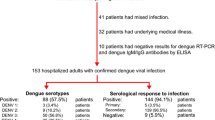Abstract
Objective
To identify WHO 2009 warning signs that can predict time taken for progression to severe dengue in a pediatric population.
Design
Prospective analytical study over 1 year and 2 months.
Setting
Tertiary care center.
Participants
350 children aged 1 mo-12 y with serologically confirmed dengue without co-morbidities/co-infections; consecutive sampling.
Procedure
At admission, clinical and laboratory details were noted. Disease progression, time of onset of each warning sign, hematocrit, and platelet counts were recorded daily till discharge/death. If progressing to severe dengue, its time of onset was noted. Time to event analysis with Log Rank test, Kaplan Meier plots and Cox Proportional Hazards Model was done.
Outcome Measures
Primary outcome was time interval from onset of first warning sign to onset of severe dengue (defined as per WHO 2009 guidelines). Predictors were WHO 2009 warning signs: abdominal pain, lethargy, persistent vomiting, mucosal bleed, clinical fluid accumulation, hepatomegaly >2 cm, hematocrit ≥0.40 and platelet count <100×109/L.
Results
Among 350 children followed up completely till discharge/death, 90 developed severe dengue (event) while 260 did not (censored). Median age of study population was 7.75 y. Clinical fluid accumulation [(P=0.002, Hazard Ratio (HR) 2.19, 95% CI 1.33–3.60)] and hematocrit ≥0.40 [(P=0.009, HR (95%CI) 1.715, (1.13–2.60)] were significant in univariate analysis. Final multivariate model includes clinical fluid accumulation [(P=0.02, HR (95%CI) 1.89, (1.116–3.202)], hematocrit ≥0.40 (P=0.07), mucosal bleed (P=0.56) and persistent vomiting (P=0.32).
Conclusion
WHO warning signs that predict time taken for progression to severe dengue in children include clinical fluid accumulation, hematocrit ≥0.40, persistent vomiting and mucosal bleed. Study results have implications in policy making and practice guidelines to triage children attending a health care facility with or without warning signs.
Similar content being viewed by others
References
World Health Organization. Dengue and Severe Dengue. Available from https://www.who.int/news-room/fact-sheets/detail/dengue-and-severe-dengue/. Accessed July 25, 2019.
National Vector Borne Disease Control Programme. Dengue. Dengue cases and deaths in the country since 2010. Available from https://www.nvbdcp.gov.in/dencd.html/. Accessed July 25, 2019.
World Health Organization. Dengue Guidelines for diagnosis, treatment, prevention and control: New edition 2009. Available from: https://www.who.int/rpc/guidelines/9789241547871/en/. Accessed July 25, 2019.
Alexander N, Balmaseda A, Coelho ICB, Dimaano E, Hien TT, Hung NT, et al. Multicentre prospective study on dengue classification in four South-east Asian and three Latin American countries. Trop Med Inter Health. 2011;16:936–48.
DinhThe T, Le Thi Thu T, Nguyen Minh D, Tran Van N, Tran Tinh H, Nguyen Van Vinh C, et al. Clinical features of Dengue in a large Vietnamese cohort: Intrinsically lower platelet counts and greater risk for bleeding in adults than children. PLoSNegl Trop Dis. 2012;6:e1679.
Sreenivasan P, S Geetha, K Sasikala. Development of a prognostic prediction model to determine severe dengue in children. Indian J Pediatr. 2018;85:433–39.
Lam PK, Ngoc TV, Thu Thuy TT, Hong Van NT, Nhu Thuy TT, Hoai Tam DT, et al. The value of daily platelet counts for predicting dengue shock syndrome: Results from a prospective observational study of 2301 Vietnamese children with dengue. PLoS Negl Trop Dis. 2017;11: e0005498.
Norman GR and Streiner DL. Nonparametric statistics. Life Table (Survival Analysis). In: Norman GR and Streiner DL, editors. Biostatistics. The bare essentials. Ontario: B.C Decker Inc; 1998. P. 182–94.
Bradburn MJ, Clark TG, Love SB and Altman DG. Survival analysis Part III: Multivariate data analysis-choosing a model and assessing its adequacy and fit. Br J of Cancer. 2003;89:605–11.
Hanif A, Butt A, Ahmed A, Sajid MR, Ashraf T, Nawaz AA. Survival analysis of Dengue patients in relation to severity of liver dysfunction in Pakistan. Adv Biolog Res. 2015;9:91–94.
Basu B, Roy B. Acute renal failure adversely affects survival in pediatric Dengue infection. Indian J Crit Care Med. 2018;22:30–33.
Acknowledgements
Dr Sasikala K, Director, CERTC, Government Medical College, Thiruvananthapuram for the conduct of this study.
Funding
None
Author information
Authors and Affiliations
Contributions
PS: conceived the idea, designed the methodology, collected and analysed data and prepared the manuscript; GS: guided conduct of the study, critically reviewed the manuscript; SKA: elaborated the concept, interpreted the results, critically reviewed the manuscript and approved final version to be published. All authors approved the final version of manuscript, and are accountable for all aspects related to the study.
Corresponding author
Ethics declarations
Institutional Review Board, Government Medical College, Thiruvananthapuram; No. 06/62/2015/MCT, dated December 09, 2015.
Additional information
Competing interests
None stated.
Rights and permissions
About this article
Cite this article
Sreenivasan, P., Geetha, S. & Santhosh Kumar, A. WHO 2009 Warning Signs as Predictors of Time Taken for Progression to Severe Dengue in Children. Indian Pediatr 57, 899–903 (2020). https://doi.org/10.1007/s13312-020-1989-1
Received:
Revised:
Accepted:
Published:
Issue Date:
DOI: https://doi.org/10.1007/s13312-020-1989-1




